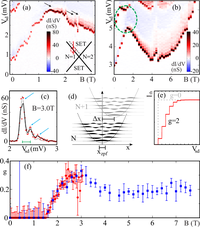With such a large frequency, the harmonic oscillator is at typical dilution refrigerator temperatures T < 100mK fully quantized. The mechanics now becomes visible in the transport spectrum of the quantum dot within the carbon nanotube as so-called Franck-Condon sidebands: For current to pass through the nanotube, an electron has to tunnel onto the quantum dot and then off it again. In our nanomechanical system, however, the mechanical equilibrium position depends on the electrostatic forces on the nanotube, and thus on the charge on it - the equilibrium position for N electrons is different from the one for N+1 electrons. This means that tunneling in is suppressed by a geometric factor describing this coupling, i.e., the limited overlap between the macromolecule wavefunction in both situations. If we provide enough energy to reach excited vibrational states, this suppression is partially lifted. Thus, as function of applied bias voltage, we see a series of steps in the current or lines in the differential conductance.
In our article, we demonstrate for the first time Franck-Condon sidebands in a clean carbon nanotube quantum dot with known absolute number of trapped electrons. We evaluate the coupling parameter and see that it depends on a magnetic field, but also on the precise electronic state that the electrons tunnel through. The so-called valley quantum number turns out to be crucial here; it is related to the angular momentum of the electron. Comparing our evaluation results with our previous calculations on the distribution of electrons along the nanotube axis, we propose a model that describes the coupling parameter as function of magnetic field for different quantum states. While the model is a simplification, it nevertheless is clearly able to qualitatively reproduce our experimental results of a tunable electron-vibron coupling.
"Magnetic field control of the Franck-Condon coupling of few-electron quantum states"
P. L. Stiller, A. Dirnaichner, D. R. Schmid, and A. K. Hüttel
Physical Review B 102, 115408 (2020);
arXiv:1812.02657
(PDF)

No comments:
Post a Comment